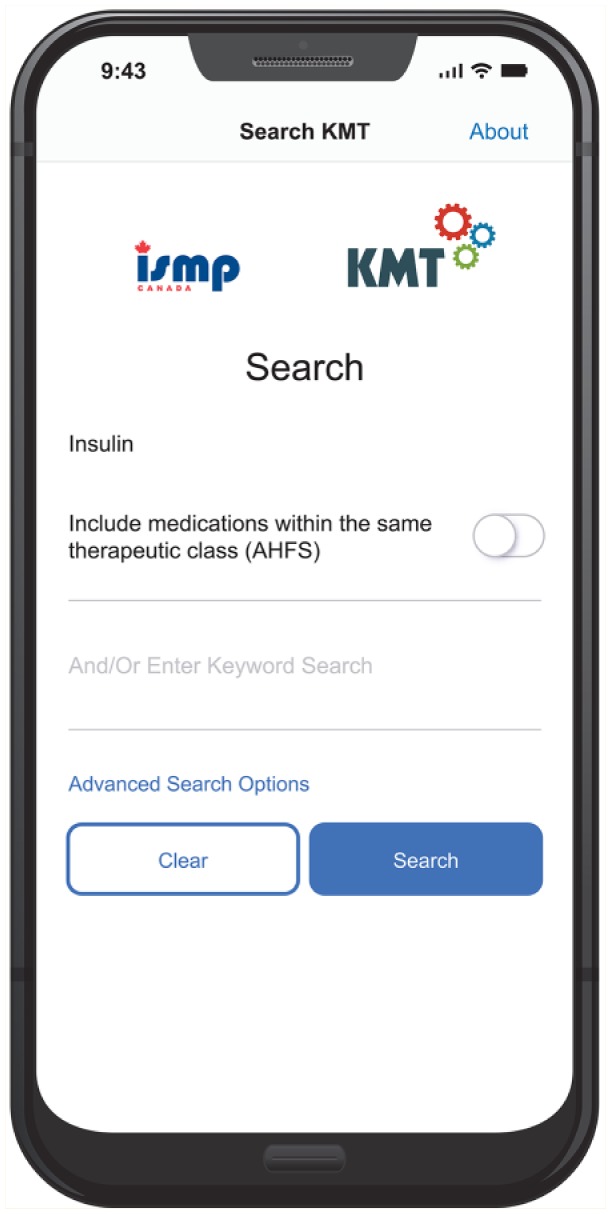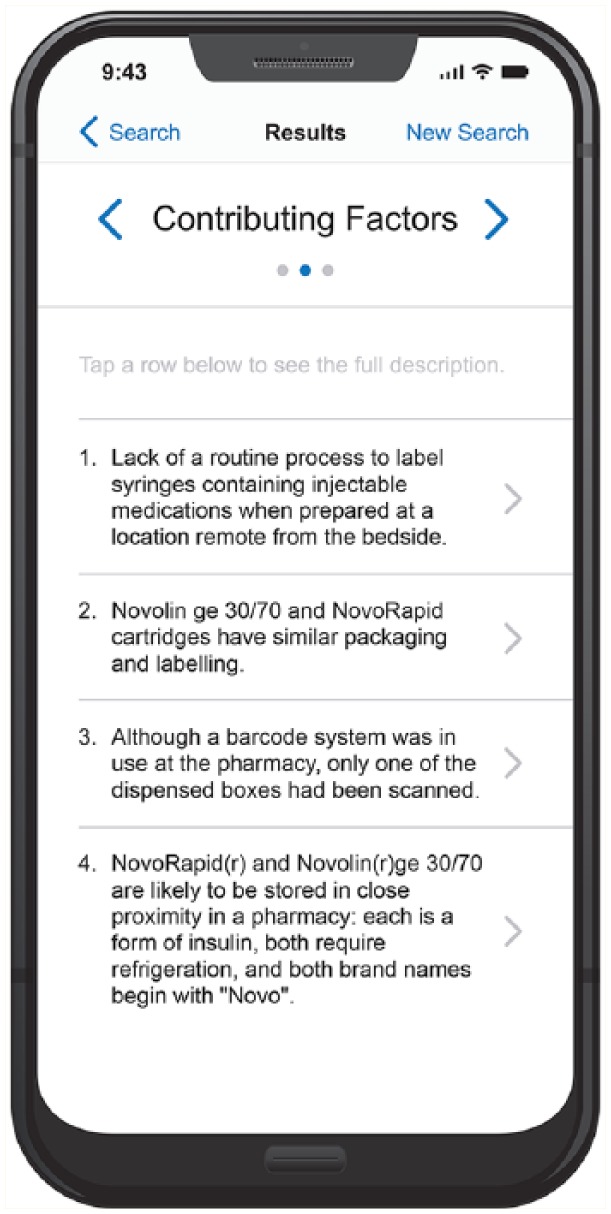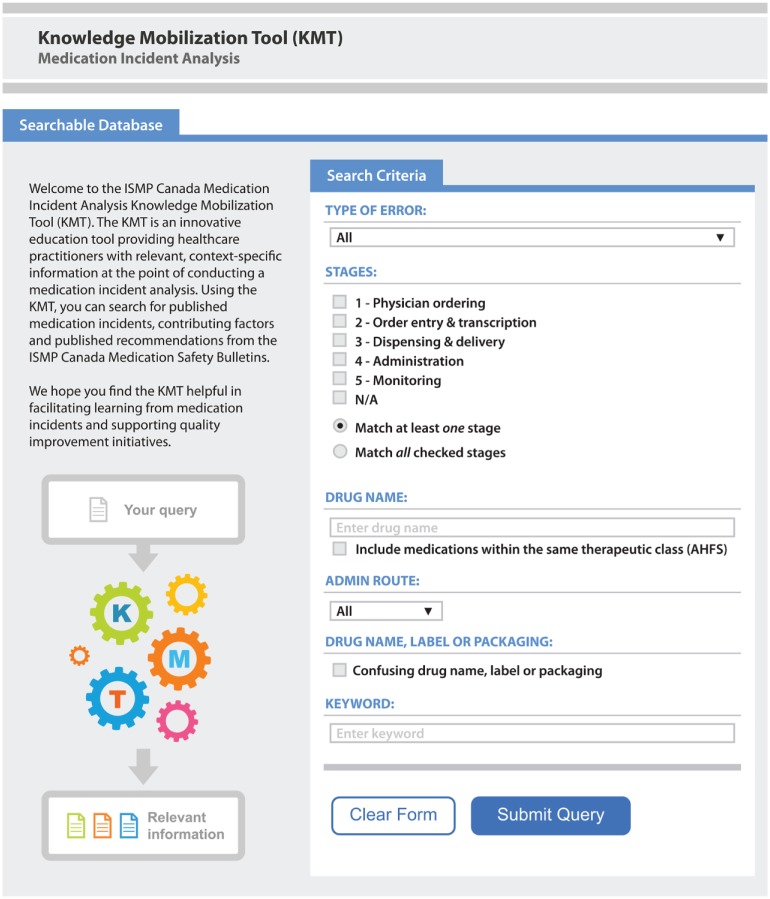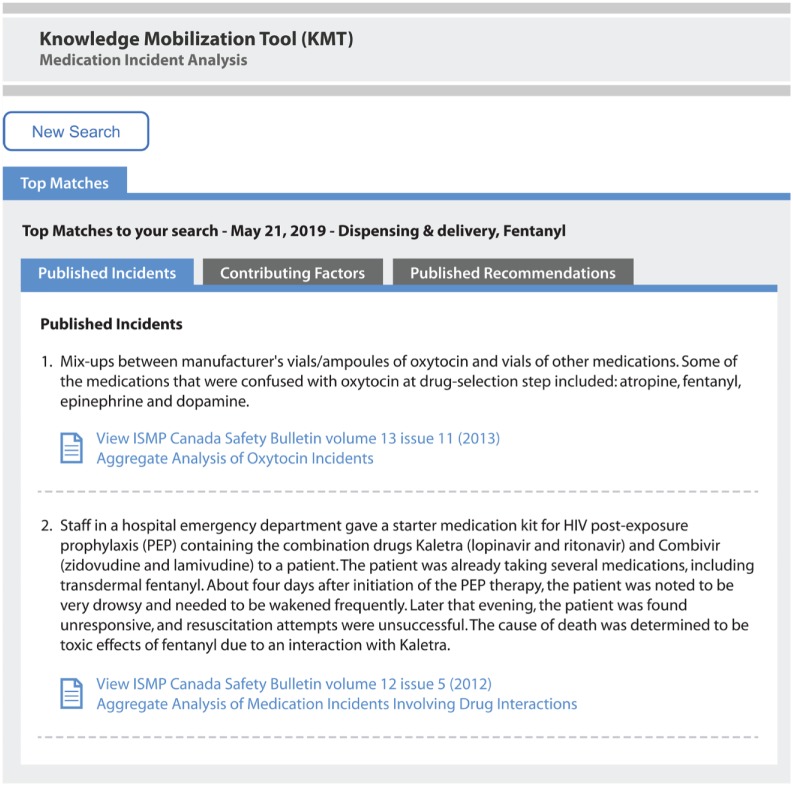Introduction
Medication safety is a continual priority in health care. One of the main principles in medication safety work is shared learning among health care professionals.1 The Institute for Safe Medication Practices Canada (ISMP Canada) publishes Safety Bulletins (https://www.ismp-canada.org/ISMPCSafetyBulletins.htm) that provide education and include descriptions of reported medication incidents, contributing factors and recommendations. Seventeen years’ worth of safety bulletins have been published, and this wealth of information continues to grow. It would be ideal if such medication safety shared expertise could be accessible at your fingertips and at the point of care.
In an endeavour to make patient safety and medication incident analysis information more productive and user-friendly, the Knowledge Mobilization Tool (KMT) (https://secure.ismp-canada.org/KMT/) was created in 2016 to complement safety initiatives across all health care organizations, with support from an education grant of the Canadian Society of Hospital Pharmacists (CSHP) Research and Education Foundation.2,3
The KMT allows users to search for relevant pieces of information that can be obtained from published ISMP Canada Safety Bulletins. Search criteria include types of errors, stages of medication use, drug name and/or American Hospital Formulary Service (AHFS) classification, administration route and other keywords (Figure 1). The KMT will then return information from 3 categories: published incidents, contributing factors and published recommendations.
Figure 1.
The Knowledge Mobilization Tool search criteria (web version shown)
For example, if drug name: “fentanyl” and stages: “administration” were used in the search criteria, the KMT would populate search results of published incidents from ISMP Canada Safety Bulletins related to fentanyl and its administration, as well as contributing factors and recommendations that are relevant to this combination of search terms.
Shortly after the launch of the web-based KMT, we recognized the need to maximize its impact on patient care, and hence the development of the KMT mobile application was begun in 2017 with support from the University of Toronto Provost’s Instructional Technology Innovation Fund (ITIF). The KMT mobile app enables practitioners and health care organizations to search and learn from reported medication incidents in a timely fashion, ultimately contributing to improved and safer patient care. As incidents are discovered at an institution or in a practice setting, a quick search on the KMT web or mobile app can provide information to health care practitioners about similar previously reported incidents, insight into why such errors may have occurred, potential action plans to address the incidents and so on.
How to Use the Knowledge Mobilization Tool
The KMT uses categories of search criteria as well as any free-text keywords. You can enter search criteria based on what information you are looking for and for what purposes.
If you are looking for reports and recommendations from a similar type of incident or near miss that occurred at your practice site, consider entering the drug name and one of the other criteria that is pertinent to the incident (Figure 1). If you find that this populates too many results, you can then consider including another search criterion to narrow down those results.
For proactive learning purposes, consider day-to-day practice scenarios and whether contributing factors and published recommendations exist for them. For example, if you dispense fentanyl patches in your practice, you can enter “fentanyl” as the drug name and check off “Dispensing & delivery” in the stage criteria. As of this writing, 2 published incidents, 1 contributing factor and 4 published recommendations are identified using these search criteria.
One published incident highlights a drug interaction between Kaletra® and transdermal fentanyl. Toxic levels of fentanyl can be caused by this interaction, and this incident led to a patient’s death (Figure 2). This information may then become a learning point for your practice and your practice site. It also highlights a check that can be conducted in your pharmacy management software, to ensure this drug interaction is flagged in its drug utilization review process. The contributing factor identified from the search can also serve as a reminder to staff about the importance of carefully reading decimal points, as misreading of dose designations (e.g., trailing zero or lack of leading zero)4 can lead to incorrect doses of fentanyl. These pieces of learning can be discussed at team meetings where brainstorming of prevention strategies can occur.
Figure 2.
An example of the Knowledge Mobilization Tool (KMT) search results for “Published Incidents” (web version shown)
The published recommendations section can serve as a checklist of action items. These recommendations can be implemented to prevent medication incidents from occurring. Consider if they are suitable for your practice site and then putting together an implementation plan accordingly. For example, there is a recommendation that states, “For outpatients, provide and review written information with the patient (and family) whenever a new fentanyl patch dose is dispensed to ensure that information (e.g., signs and symptoms of overdose) is not overlooked.” This may lead to a discussion during a team meeting about how to operationalize this, including researching a handout to provide to patients and caregivers and making sure that a handout is placed next to the supply of fentanyl patches as a reminder to give one to patients when appropriate. For additional reading on creating effective recommendations, consider the hierarchy of effectiveness mentioned in a recent ISMP Canada article.5
Given the vast amount of learning available through the KMT, consider adding its use into your organization’s or quality improvement committee’s regular medication safety discussions. The KMT can be involved by providing insight into similar incidents that have occurred at your practice site or including considerations from a search of a high-alert medication.
For all generated search results, the KMT also links to the full ISMP Canada Safety Bulletin where results were derived. These safety bulletins can provide more information about how the incident was identified, the medication safety theme that was generated from the incident analyses, corresponding solutions developed and more.
Hypothetical case scenario using the KMT
A patient returned to the pharmacy to discuss an insulin mix-up. The patient reported that he had picked up NovoRapid® Penfill instead of Novolin®ge 30/70. The pharmacist assessed the patient’s diabetes to evaluate the impact of the error and concluded that no harm was done, as the patient still had a supply of Novolin®ge 30/70 at home and the NovoRapid® Penfill was not used. The patient expressed concern that this might happen again and the pharmacist assured him that the incident would be investigated. Upon closer inspection, the pharmacist noted that the packaging of the 2 types of insulin is almost identical in shape, size and colour. The pharmacist was curious whether this was something other pharmacists were aware of and if it had been reported before. As her shift ended, she decided to find out on the KMT, using the search criteria of “insulin” as the drug name and checking off the box for “Confusing drug name, label or packaging.” Upon reviewing the results, the pharmacist identified that this error had been reported before and the search result appeared in the contributing factors section: “Novolin®ge 30/70 and NovoRapid® cartridges have similar packaging and labeling” (Figure 3 and Figure 4). The pharmacy’s staff meeting was coming up, so the pharmacist decided to email and share the safety bulletin that the search result was associated with to the pharmacy team for further review.
Figure 3.

Screenshot of search page of the Knowledge Mobilization Tool (KMT) as mobile application
Figure 4.

Screenshot of contributing factors search results within KMT mobile application
User feedback
Evaluation of the KMT user experience was performed. Out of the 28 surveyed responses from ISMP Canada staff members and external health care practitioners, 89.3% found that KMT was useful for medication safety inquiries. Testimonials include the following:
[KMT] offers flexibility for the user to search for either very specific or very broad.
[KMT is a] very powerful tool for frontline staff to search previously published resources.
[The KMT is a] one-stop shopping for publications and recommendations related to specific issues.
Conclusion
The KMT is a valuable tool to support pharmacy and medication-use continuous quality improvement initiatives. It is a resource that places the expertise of years of medication safety analysis at the users’ fingertips and facilitates the searching process by health care professionals for contributing factors and recommendations related to incidents that occur in the frontlines. Search results of published incidents can also help practitioners recognize and understand system-based factors rather than focusing on individual blame, which can ultimately contribute to positive patient safety culture changes.
The KMT is currently accessible as a website (https://secure.ismp-canada.org/KMT/), an Android or iOS mobile application, on the Google Play Store or the Apple App Store, respectively.
Acknowledgments
The authors would like to acknowledge the following ISMP Canada team members and pharmacy professionals, including Lindsay Yoo, Sonya Dhanjal, Gary Lee, Adrian Boucher, Jim Kong and Jacky Yu for testing and providing feedback during the development of the KMT mobile application. The contribution from Advanced Pharmacy Practice Experience (APPE) students from the University of Toronto Leslie Dan Faculty of Pharmacy and co-op pharmacy students from the University of Waterloo School of Pharmacy was extremely helpful in the development of the KMT search database.
Footnotes
Author Contributions:Roger Cheng provided inception, development, testing and implementation of KMT web version. Certina Ho initiated this manuscript and managed KMT mobile application development and user testing. Edmond Chiu tested KMT mobile application during and after development and wrote the final draft of this manuscript.
Funding:Canadian Society of Hospital Pharmacists (CSHP) Research and Education Foundation Education Grant 2013 for supporting the development of the KMT web version and the University of Toronto Provost’s Instructional Technology Innovation Fund (ITIF) 2016 and Mobile Application Development Lab (MADLab) for supporting the KMT mobile application development.
Statement of Conflicting Interests:No conflict of interests are identified.
ORCID iD:Edmond Chiu  https://orcid.org/0000-0002-0807-3293
https://orcid.org/0000-0002-0807-3293
References
- 1. Canadian Patient Safety Institute. Medication safety. Ottawa (ON): The Institute; c2016. Available: https://www.patientsafetyinstitute.ca/en/About/PatientSafetyForwardWith4/pages/medication-safety.aspx (accessed Apr. 23, 2019). [Google Scholar]
- 2. Chan M, Cheng R, Duwyn K, et al. Medication Incident Analysis Knowledge Mobilization Tool: medication safety expertise at your fingertips [poster]. Can J Hosp Pharm 2016;69(1):77. Available: https://www.ismp-canada.org/download/posters/PPC2016_KMT.pdf (accessed Apr. 23, 2019). [DOI] [PMC free article] [PubMed] [Google Scholar]
- 3. Chiu E, Ho C. The next generation tool in medication safety: the Knowledge Mobilization Tool. Hospital News 2017 Dec;29. Available: https://www.ismp-canada.org/download/hnews/201712-HospitalNews-KMT.pdf (accessed Apr. 23, 2019).
- 4. ISMP Canada. Do not use dangerous abbreviations, symbols and dose designations. 2018. Available: https://www.ismp-canada.org/download/ISMPCanadaListOfDangerousAbbreviations.pdf (accessed Apr. 23, 2019).
- 5. ISMP Canada. Designing effective recommendations. Toronto: Ontario Critical Incident Learning; 2013:4 Available: www.ismp-canada.org/download/ocil/ISMPCONCIL2013-4_EffectiveRecommendations.pdf (accessed Apr. 23, 2019). [Google Scholar]




